On This Page
Table of Contents
The King Project
List of Figures
List of Figures
OVERVIEW
Commodity:
Gold and Copper)
Target Types:
Mesothermal veins, replacement mantos, porphyry- style mineralization
Location:
Spences Bridge Gold Belt 50 kilometres west of Kelowna, B.C.
Size:
3200 ha
SUMMARY
The King Property is located 50 kilometres west of Kelowna, B.C., and is comprised of eight MTO located mineral claims covering an area of 3206.61 hectares in the Nicola Mining Division of British Columbia. The claims are located on NTS map sheets 92H.089 and 92H.090. The claims are owned 100 percent by Barranco Gold Mining Corp. Current exploration is targeting gold-bearing structures in intrusive and volcanic rocks.
INTRODUCTION
Map Place:
www.empr.gov.bc.ca/mining/geoscience/mapplace/
Mineral Titles Online:
Geoscience BC:
as well as the mineral assessment work reports from the King Property area that have been historically filed by various companies.
The author reserves the right but will not be obliged; to revise the report and conclusions if additional information becomes known subsequent to the date of this report.
The information, opinions, and conclusions contained herein are based on:
- Information available to the author at the time of preparation of this report
- Assumptions, conditions, and qualifications as set forth in this report
Units and Measurements
Table 1: Definitions, Abbreviations, and Conversions
Units of Measure
Abbreviation
Units of Measure
Abbreviation
Above mean sea level
amsl
Micrometre (micron)
mm
Annum (year)
a
Miles per hour
mph
Billion years ago
Ga
Milligram
mg
Centimetre
cm
Milligrams per litre
mg/L
Cubic centimetre
cm3
Millilitre
mL
Cubic metre
m3
Millimetre
mm
Day
d
Million
M
Days per week
d/wk
Million tonnes
Mt
Days per year (annum)
d/a
Minute (plane angle)
M
Dead weight tonnes
DWT
Minute (time)
min
Degree
°
Month
mo
Degrees Celsius
°C
Ounce
oz
Degrees Fahrenheit
°F
Parts per billion
ppb
Diameter
ø
Parts per million
ppm
Gram
g
Percent
%
Grams per litre
g/L
Pound(s)
lb.
Grams per tonne
g/t
Power factor
pF
Greater than
>
Specific gravity
SG
Hectare (10,000 m2)
ha
Square centimetre
cm2
Gram
g
Square inch
in2
Grams per litre
g/L
Square kilometre
km2
Grams per tonne
g/t
Square metre
m2
Greater than
>
Thousand tonnes
kt
Kilo (thousand)
k
Tonne (1,000kg)
t
Kilogram
kg
Tonnes per day
t/d
Kilograms per cubic metre
kg/m3
Tonnes per hour
t/h
Kilograms per hour
kg/h
Tonnes per year
t/a
Kilometre
km
Total dissolved solids
TDS
Kilometres per hour
km/h
Total suspended solids
TSS
Less than
<
Week
wk
Litre
L
Weight/weight
w/w
Litres per minute
L/m
Wet metric tonne
wmt
Metre
King
Yard
yd.
Metres above sea level
masl
Year (annum)
a
Metres per minute
m/min
Year
yr.
Metres per second
m/s
Metric ton (tonne)
t

PROPERTY DESCRIPTION AND LOCATION
The King Property consists of seven non-surveyed mineral claims totalling 3206.61 hectares located on NTS map sheets 092H.089 and 92H.090 centered at Latitude 49° 55” Longitude 120° 51’. The claims are located within the Nicola Mining Division, of British Columbia. The Mineral claims are shown on Figure 2, and the claim details are illustrated in the following table:
Table 2: Property Tenure Information
Title Number
Claim Name
Owner
Title Type
Good To Date
Area (ha)
1063741
KING
118700 (100%)
Mineral
2021/DEC/31
83.26
1067940
KING 2
118700 (100%)
Mineral
2021/DEC/31
416.36
1067941
KING 3
118700 (100%)
Mineral
2021/DEC/31
416.36
1069933
KING – 4
118700 (100%)
Mineral
2021/DEC/31
458.11
1070217
KING – 5
118700 (100%)
Mineral
2021/DEC/31
520.52
1074978
KING – 6
118700 (100%)
Mineral
2021/DEC/31
562.14
1074979
KING – 7
118700 (100%)
Mineral
2021/DEC/31
749.86
BC Mineral Titles Online indicates that Barranco Gold Mining Corp. is the current registered owner of the tenures listed above.

The author undertook a search of the tenure data on the government of British Columbia Mineral Titles Online (MTO) website which confirms the geospatial locations of the claim boundaries and the property ownership as of April 3, 2020.
Figure 1: Regional Location Map
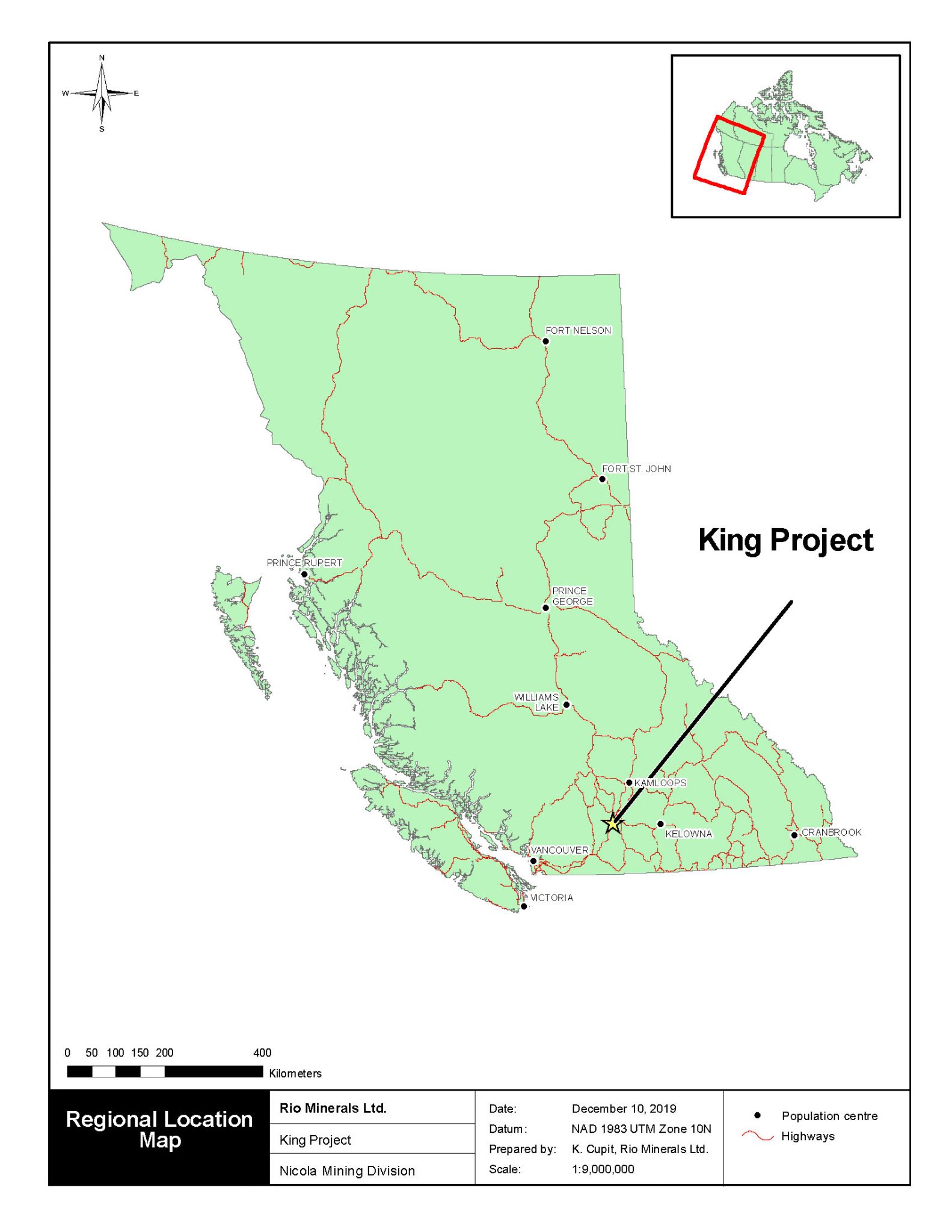
Regional Location Map (Satellite)
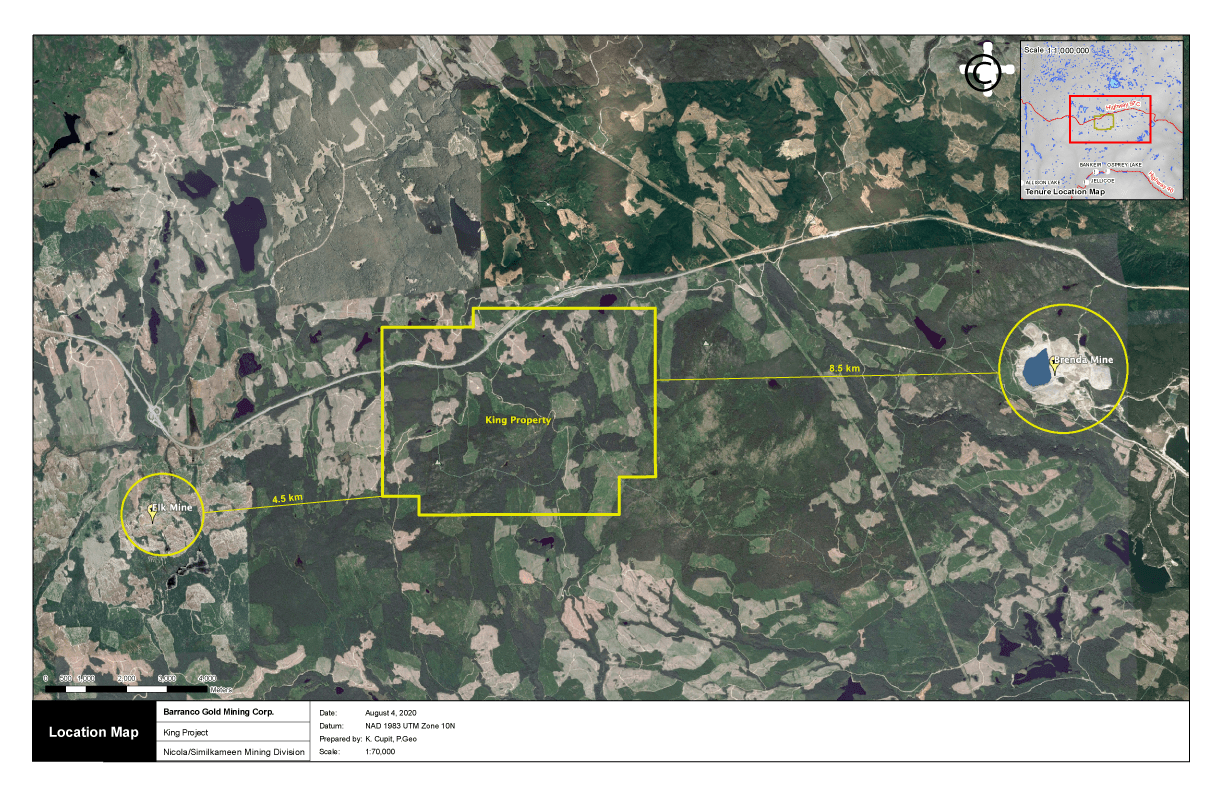
Figure 2: Property Tenure Map

ACCESSIBILITY, CLIMATE, PHYSIOGRAPHY, LOCAL RESOURCES, AND INFRASTRUCTURE
The King property is located 50 kilometres west of Kelowna in south-central British Columbia. It is centered on latitude 49 degrees 55′ north and longitude 120 51’ degrees west within NTS Map areas 92H.089 and 92H.090. Access to the property is via Highway 97C (Okanagan connector) 40 km west from Westbank. The highway transects the claims from northeast to southwest.
Access to the property is provided by secondary roads extending from the old Quilchena power line road via Sunset Main to Paradise Lake and to Reservoir Lake as well as numerous secondary logging roads.
The claims enclose an area of a broad uplands plateau with limited relief. Elevations range from 1550m to 1850m above sea level. Roughly 10 percent of the area is covered by small lakes or marsh. Bedrock exposure is limited, being confined to highway rock cuts and to the southeast portion of the claims were some steeper slopes are present. Northerly-flowing, small to medium size streams meander across the property but most have not eroded deeply enough to expose bedrock.
Forest cover comprises pine, fir, spruce, and balsam. Clear cut logging has been undertaken on portions of the claims. Annual temperatures range from -20 degrees to 30 degrees centigrade and precipitation is low to moderate. The area is basically snow-free from mid-June through November.
HISTORY
Copper exploration which consisted of soil sampling, airborne EM/Mag, and I.P. surveys was undertaken from 1966 to 1968. Minor copper showings were discovered in volcanic and intrusive host rocks.
From 1986 to the present, high grade gold vein systems have been the subject of exploration by Fairfield Minerals Ltd. and Almaden Minerals Ltd. on the adjoining Elk property located four kilometres to the southwest of the King property. Geochemical and geophysical surveys, trenching, and diamond drilling at Elk have revealed several gold-bearing structures, one of which contains a drill indicated geological resource in excess of 200,000 ounces of gold with an average grade of 0.647 oz/ton Au.
Reconnaissance prospecting and sampling in the King property area was carried out by Cordilleran Engineering Ltd. from 1986 through 1991. Highly anomalous gold values as well as high values in silver, copper, lead, zinc, and arsenic were returned from a number of stream sediment, soil, and rock samples.
GEOLOGICAL SETTING AND MINERALIZATION
Regional Geology
After JWH Mongery, et al, 1989
Regional geology in the area of the King property is illustrated on the northeast part of GSC map 41-1989, Hope, mapped by J.W.H..Mongery:
The claims straddle a narrow, north-south neck of the Pennask batholith approximately 5 km wide and in contact on the east and west with volcanic and sedimentary rocks of the Nicola Group. The batholith comprises white to grey, medium to fine grained granodiorite of Late Triassic to Early Jurassic age. To the south it is in contact with Late Jurassic coarse-grained pinkish granite to granodiorite. Nicola Group rocks consist of Late Triassic andesite to basalt flows and pyroclastics changing facies to the east to a sequence of interbedded argillite, sandstone, tuff, and minor limestone.
Property Geology
After Rowe, et al, 1989
Rock cut exposures along the highway on the south-central claims consist predominantly of coarse-grained pinkish granite. Shear zones within the granite are often accompanied by argillic to phyllic alteration over widths of up to several meters with local narrow quartz veins emplaced in the shears. Iron and manganese oxides are common in the alteration zones. Grab samples of quartz vein material with disseminated pyrite have returned values of up to 24100 ppb Au and 122.1 ppm Ag (Rowe, J. 1991. AR 21922). Andesite dykes up to 0.5m wide of probable Tertiary age have been observed cutting granite near mineralized quartz veins. Similar dykes are spatially associated with gold-bearing quartz veins on the nearby Elk property.
A grab sample of siliceous volcanic rock with disseminated to semi-massive arsenopyrite taken from the eastern portion of the property returned 1830 ppb Au and 30530 ppm As. Samples taken in the middle of the claim group of quartz veins up to 6 cm wide in sheared, altered volcanic rock returned values up to 0.071 oz/ton Au and 30.5 oz/ton Ag with minor copper, lead, and zinc. A grab sample taken approximately 1 kilometer south of the road of similarly mineralized quartz vein material gave values of 24100 ppb Au (0.70 oz/ton) and 85.6 ppm Ag (2.50 oz/ton. Rowe, J. 1991. AR 21922).
Shears and vein structures measured on the property have predominantly east to northeast strikes and moderate to steep southerly dips. It has been observed that most of the gold-bearing structures in the region have similar trends.
The geological setting is similar to that of the adjoining Siwash (Elk) property where, 4 km to the southwest, a gold-bearing quartz vein system cutting granitic and volcanic rocks is being explored. In addition, the Brenda copper-molybdenum deposit located 20km east of the King property is hosted by similar geological units.
Figure 3: Regional Geology Map
Minfile Showings Located on the Property
The King showing (092HNE297): occurs along a logging roadcut, 1.5 kilometres southeast of the Coquihalla Highway (Okanagan Connector), 4.0 kilometres northeast of Culmination Point and 3.5 kilometres west-southwest of the summit of Pennask Mountain.
A quartz vein, 1 centimetre wide, cuts bleached, pyritic andesitic ash tuff of the Upper Triassic Whistle Creek Formation (Nicola Group). A sample of selected chips analysed 0.68 gram per tonne gold (Assessment Report 21922, page 9, Table 2, sample L89-R1D). The showing was sampled by Kingsvale Resources Inc. in 1991.
The King 6 showing (092HNE298): occurs along the north side of the Coquihalla Highway (Okanagan Connector), 2.6 kilometres north-northwest of Culmination Point and 7.4 kilometres west of the summit of Pennask Mountain.
A drusy quartz vein, 10 centimetres wide, cuts coarse-grained, feldspar megacrystic granite of the Middle Jurassic Osprey Lake batholith. The vein is mineralized with scattered blebs of chalcopyrite. A selected sample analysed 0.41 grams per tonne gold and 7.8 grams per tonne silver (Assessment Report 21922, page 9, Table 2, sample Q1b-R3).
The King 8 showing (092HNE299): is on the north side of the Coquihalla Highway (Okanagan Connector), 2.7 kilometres north-northeast of Culmination Point and 6.0 kilometres west of the summit of Pennask Mountain.
A shear zone, 70 centimetres wide, cuts coarse-grained, phyllic, sericitic-altered granite of the Middle Jurassic Osprey Lake batholith, near an andesitic dike. The showing is approximately 100 meters south of the contact with andesitic ash and lapilli tuff of the Upper Triassic Whistle Creek Formation (Nicola Group). A pyritic quartz-calcite vein/breccia is associated with the shear zone. A series of selected chips from the vein yielded 0.44 grams per tonne gold and 10.6 grams per tonne silver (Assessment Report 21922, page 9, Table 2, sample Q17-R2A).
Figure 4: Minfile Location Map

EXPLORATION
PREVIOUS EXPLORATION
A total of 1209 soil samples were collected from the King property in 1991. Wide spaced (400m x 50m) initial grid sampling yielded 1074 samples. These lines were established in two areas of the property covering the contact zones of the batholith and areas of known gold mineralization which were believed to have the best potential for the discovery of gold deposits.
East-west claim lines served as baselines. They were measured with a hip chain, marked with pink flagging and at certain stations, marked with grid-numbered, waterproof Tyvek tags plus pink and blue flagging. North-south soil lines were established using hip chain and compass, and soil stations at 50m intervals were similarly identified with tags plus orange and blue flagging. Subsequent fill-in line locations were determined from existing initial grid stations.
Samples were collected from the „B“ horizon with mattocks and placed in Kraft paper bags marked with the appropriate grid coordinates. The samples were sent to Acme Analytical Laboratories Ltd. in Vancouver where they were dried, sieved, and the -80 mesh fraction used for gold analysis. Each sample was tested for gold by atomic absorption following aqua regia digestion and MIBK extraction from a 10-gram sample (Rowe, J. 1991. AR 21922).
The wide-spaced grid sampling of selected portions of the property was adopted to economically explore the largest extent reasonable, at the risk of missing narrow, high grade gold veins which may lie between 400 meter-spaced lines.
The initial grid sampling returned nine values greater than 20 ppb Au to a high of 130 ppb, dispersed widely across the property. Fill-in sampling around these sites confirmed the existence of anomalous gold in three of the areas by yielding additional values of 94 ppb Au (Rowe, J. 1991. AR 21922).
Wide-spaced soil sampling, with limited follow-up over approximately one-quarter of the King property has indicated three zones of anomalous gold.
Table 3: Historic Rock Sample Descriptions:
Sample ID
Locality
Sample Type
Description
Sample Width (cm)
Au ppb
Ag ppm
Q16-R3
KING
Grab
Broken sub-crop, 10cm drusy qtz vein with scattered blebs of chalco
10
410
7.8
Q17-R2A
KING
Chip
In-situe pyritic qtz-calcite veins. Bx assoc w 70cm wide shear zone in phyllic altered granite near andesite dyke
grab
440
10.6
Q20-R2
KING
Float
Selected grabs from several qtz veins, cobbles up to 10cm wide. Drusy, with minor pyrite and chalcopyrite
grab
820
–
Q20-R6
KING
Float
Several small, angular qtz vein fragments – in part hematitic w/fe and minor oxides
grab
720
122.1
Q20-R6
KING
Chip
Selected chips from in-situe 1 cm qtz vein cutting bleached, silicic, pyritic andesite
grab
680
–
L89-R14
KING
Float
Selected grab of qtz flooded granite w/clots of py, cpy, qn, sp
grab
24100
85.6
L37-R1
KING
Float
Selected grab, andesite-basalt w/strongly dissem pyrite/arsenopyrite
grab
1830
–

EXPLORATION PROCEDURES
Rock sample locations were marked in the field with pink and blue flagging tape and their respective locations along with sample descriptions were recorded. The samples were then placed in marked poly bags, zap-strapped, and delivered to Acme Laboratories located Vancouver, BC for analysis.
Figure 5: Rock Sample Location Map

DEPOSIT TYPES
An epithermal gold deposit is one in which the gold mineralization occurs within 1 to 2 km of surface and is deposited from hot fluids. The fluids are estimated to range in temperature from less than 100°C to about 300°C and, during the formation of a deposit, can appear at the surface as hot springs. The deposits are most often formed in areas of active volcanism around the margins of continents (Norcross 1997).
Epithermal gold mineralization can be formed from two types of chemically distinct fluids — „low sulphidation“ (LS) fluids, which are reduced and have a near-neutral pH (the measure of the concentration of hydrogen ions), and „high sulphidation“ (HS) fluids, which are more oxidized and acidic. LS fluids are a mixture of rainwater that has percolated into the subsurface and magmatic water (derived from a molten rock source deeper in the earth) that has risen toward the surface. In both LS and HS models, fluids travel toward the surface via fractures in the rock, and mineralization often occurs within these conduits. LS fluids usually form large cavity-filling veins, or a series of finer veins, called stockworks, that host the gold. The hotter, more acidic HS fluids penetrate farther into the host rock, creating mineralization that may include veins, but which is mostly scattered throughout the rock.
Low sulphidation deposits can also contain economic quantities of silver and minor amounts of lead, zinc, and copper, whereas high sulphidation systems often produce economic quantities of copper. Geochemical exploration for these deposits can result in different chemical anomalies, depending on the type of mineralization involved. Low sulphidation systems tend to be higher in zinc and lead, and lower in copper, with a high silver-to-gold ratio. high sulphidation systems can be higher in arsenic and copper with a lower silver-to-gold ratio (Norcross 1997).
INTERPRETATION AND CONCLUSIONS
The King property is located in the Spences Bridge Gold Belt of British Columbia, Canada. The Spences Bridge Gold Belt is an underexplored, emerging 200-kilometre-long-by-30-kilometre-wide low-sulphidation epithermal gold belt.
Interpreted to be a failed cretaceous rift basin, it is believed the belt is prospective for Fruta del Norte style high-grade epithermal mineralization. It is close to major transportation routes and infrastructure allowing for cost-effective exploration. The SBGB is a northwest-trending belt of intermediate to felsic volcanic rocks dominated by the Cretaceous Spences Bridge Group.
The King property is located within the SBGB and hosts a geological environment similar to that of the adjoining Elk (Siwash) property. The Siwash Gold Deposit, currently owned by Almaden Minerals Ltd., is located four kilometres to the southwest. Siwash is a high-grade vein system which contains a drill indicated geological resource in excess of 200,000 ounces of gold with an average grade of 0.647 oz/ton Au.
The past-producing Brenda Mine is located 20 kilometers to the east of the King Property. The Brenda Mine operated from 1970 to 1990 and produced 278,000 tonnes of copper, 66,000 tonnes of molybdenum, 125 tonnes of silver, and 2 tonnes (64,302 oz) of gold.
Soil sampling on the King Property returned high gold in soil values over distances of up to 150 meters. Six rock samples taken on the property by Cordilleran Engineering returned up to 24.1 grams per gold and 122.1 grams per tonne silver.
Gold-arsenopyrite mineralization is known to exist on the eastern portion of the claim area, and silver-rich quartz veins have been found in the western portions of the claims.
The discovery of high-grade mineralization, excellent infrastructure, and location in the Spences Bridge Gold Belt provides a compelling target for gold/silver exploration.
List of Figures
List of Figures
SUMMARY
INTRODUCTION
In the preparation of this report, the author utilized both British Columbia and Federal Government
of Canada geological maps, geological reports, and claim maps. Information was also obtained
from British Columbia Government websites such as:
Map Place:
Mineral Titles Online:
Geoscience BC:
IMAP BC
The author visited the King Property on July 15, 2020, and August 29, 2023 during this visit the author
reviewed the geological setting. The author visited the both times with Andrew Molnar the Vendor of
the Property. Rio Minerals Ltd. was engaged to undertake the 2020 and 2023 mineral exploration
program for Barranco Gold Mines Corp. Mr. Molnar is a Principle of Rio Minerals Ltd.
The information, opinions, and conclusions contained herein are based on:
- Information available to the author at the time of preparation of this report
- Assumptions, conditions, and qualifications as set forth in this report
Historical rock sampling and assay results are critical elements of this review. The sampling
techniques utilized by previous workers are poorly described in ARIS reports and, therefore, the
historical assay results must be considered with prudence. Corp.
Units and Measurements
Table 1: Definitions, Abbreviations, and Conversions
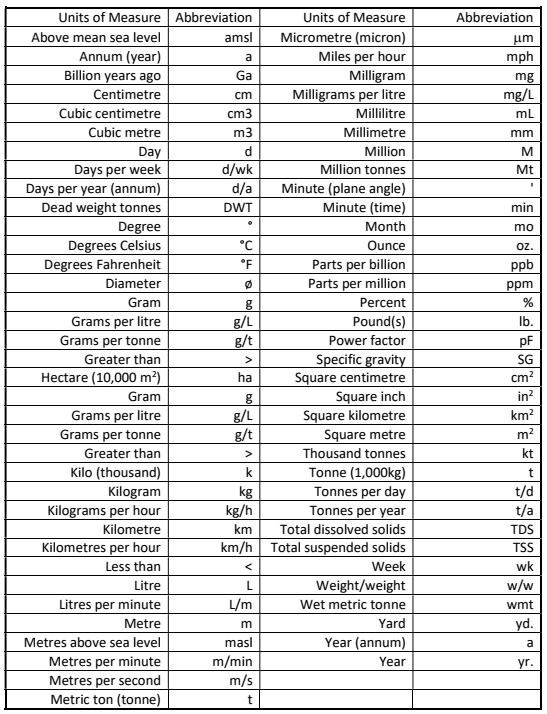
Units of Measure
Abbreviation
Units of Measure
Abbreviation
Above mean sea level
amsl
Micrometre (micron)
mm
Annum (year)
a
Miles per hour
mph
Billion years ago
Ga
Milligram
mg
Centimetre
cm
Milligrams per litre
mg/L
Cubic centimetre
cm3
Millilitre
mL
Cubic metre
m3
Millimetre
mm
Day
d
Million
M
Days per week
d/wk
Million tonnes
Mt
Days per year (annum)
d/a
Minute (plane angle)
M
Dead weight tonnes
DWT
Minute (time)
min
Degree
°
Month
mo
Degrees Celsius
°C
Ounce
oz
Degrees Fahrenheit
°F
Parts per billion
ppb
Diameter
ø
Parts per million
ppm
Gram
g
Percent
%
Grams per litre
g/L
Pound(s)
lb.
Grams per tonne
g/t
Power factor
pF
Greater than
>
Specific gravity
SG
Hectare (10,000 m2)
ha
Square centimetre
cm2
Gram
g
Square inch
in2
Grams per litre
g/L
Square kilometre
km2
Grams per tonne
g/t
Square metre
m2
Greater than
>
Thousand tonnes
kt
Kilo (thousand)
k
Tonne (1,000kg)
t
Kilogram
kg
Tonnes per day
t/d
Kilograms per cubic metre
kg/m3
Tonnes per hour
t/h
Kilograms per hour
kg/h
Tonnes per year
t/a
Kilometre
km
Total dissolved solids
TDS
Kilometres per hour
km/h
Total suspended solids
TSS
Less than
<
Week
wk
Litre
L
Weight/weight
w/w
Litres per minute
L/m
Wet metric tonne
wmt
Metre
King
Yard
yd.
Metres above sea level
masl
Year (annum)
a
Metres per minute
m/min
Year
yr.
Metres per second
m/s
Metric ton (tonne)
t
RELIANCE ON OTHER EXPERTS
PROPERTY DESCRIPTION AND LOCATION
Table 2: Property Claim Information
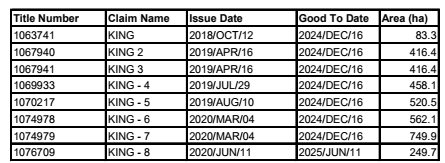
Title Number
Claim Name
Owner
Title Type
Good To Date
Area (ha)
1063741
KING
118700 (100%)
Mineral
2021/DEC/31
83.26
1067940
KING 2
118700 (100%)
Mineral
2021/DEC/31
416.36
1067941
KING 3
118700 (100%)
Mineral
2021/DEC/31
416.36
1069933
KING – 4
118700 (100%)
Mineral
2021/DEC/31
458.11
1070217
KING – 5
118700 (100%)
Mineral
2021/DEC/31
520.52
1074979
KING – 7
118700 (100%)
Mineral
2021/DEC/31
749.86
1074978
KING – 6
118700 (100%)
Mineral
2021/DEC/31
562.14
BC Mineral Titles Online indicates that Barranco Gold Mining Corp. is the current registered owner of the tenures listed above.
In British Columbia, the owner of a mineral claim acquires the right to the minerals that were available at the time of claim location and as defined in the Mineral Tenure Act of British Columbia. Surface rights and placer rights are not included. Claims are valid for one year and the anniversary date is the annual occurrence of the date of record (the staking completion date of the claim).
Figure 1: Regional Location Map

Figure 2: Property Claim Map
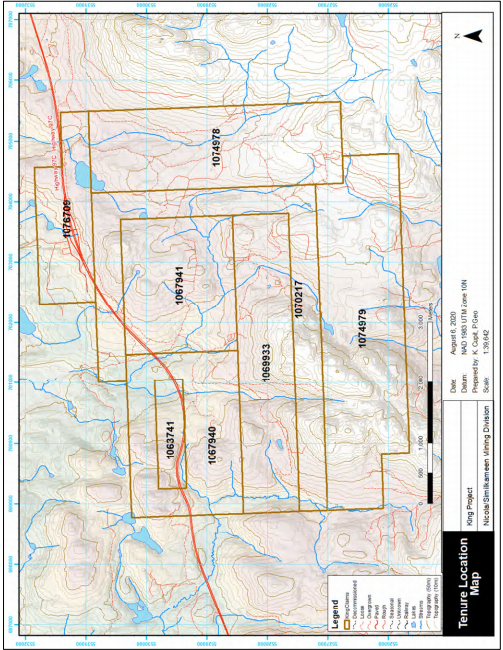
ACCESSIBILITY, CLIMATE, PHYSIOGRAPHY, LOCAL RESOURCES, AND INFRASTRUCTURE
HISTORY
Kingsvale Resources Ltd.
Select Samples from the Kingsvale Resources Ltd. program are detailed as follows:
- L37-R1 Float: selected grab; andesite-basalt w/ strongly disseminated pyrite arsenopyrite,
1830 Au ppb - L89-R1D Selected chips: from in-situ 1 cm quartz vein cutting bleached, silicic, pyritic
andesite, 680 Au ppb - Q16-R3 Selected grab: from broken sub crop; 10cm drusy quartz vein with scattered blebs
of Chalcopyrite, 410 Au ppb - Q17-R2A: Selected chips from in situ pyritic quartz-calcite vein(s)/ associated with 70 cm
wide shear zone in phyllic altered granite near andesite dyke, 440 Au ppb - Q20-R2 Float: selected grabs from several quartz vein cobbles up to 10 cm wide. Drusy,
spars pyrite, 820 Au ppb - Q20-R6Float: several small, angular quartz vein fragments in part haematitic with
magnesium oxides, 750 Au ppb.
Geoscience BC Quest South Project
Figure 3: Quest South Location
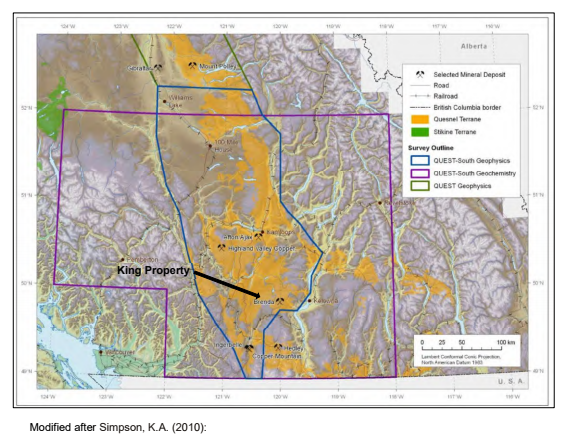
GEOLOGICAL SETTING AND MINERALIZATION
Regional Geology
- a western belt of steeply dipping, east-younging, late Carnian to Norian, subaqueous felsic,
intermediate and mafic calc-alkaline flows grading up into volcaniclastic rocks; - a central belt of early to middle Norian, subaqueous to subaerial basalt and andesite flows,
volcanic breccias, and laharic breccias of both alkalic and calc-alkalic affinity; - a younger, westerly dipping, eastern volcanic belt (Late Norian) composed of subaqueous and
subaerial, alkali, intermediate and mafic flows, volcanic breccias, and epiclastic rocks that were
deposited on, or between emergent volcanic edifices; and - an eastern sedimentary assemblage (Ladinian to middle Norian) that is overlapped by the eastern
volcanic belt and, consisting mainly of greywacke, siltstone, argillite, alkalic intermediate tuff and
reefal limestone, may record a back-arc basin;
Geology
Figure 4: Regional Geology
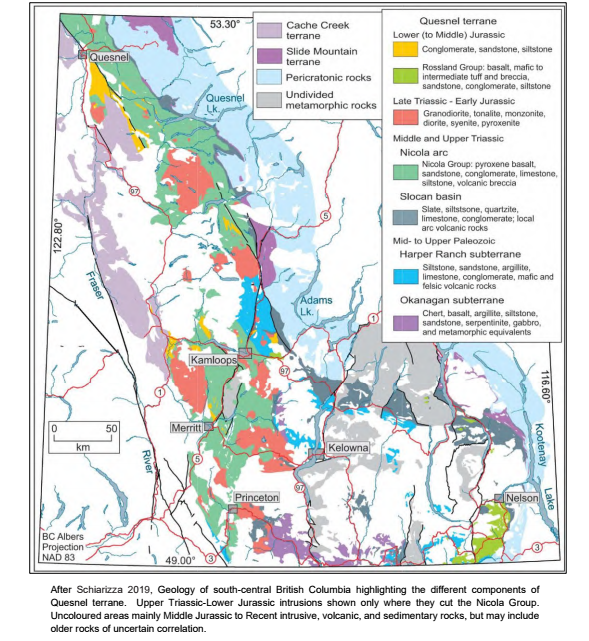
Property Geology
The following is a list, in approximate, of the various lithologies and their characteristics on the King
Property (Figure 5).
Pennask batholith (LTrJgd): The Triassic to Early Jurassic Pennask batholith is a (quartz)
diorite (feldspars>biotite/amphibole>quartz) occurring in the eastern and western portion of the
property. It ranges from foliated (near the northwestern trenches) to hornfelsed (Northeast grid) to
weakly chlorite-hematite altered. Most samples exhibit weak to moderate magnetism.
MINFILE Showings Located on the Property
Figure 5: Property Geology
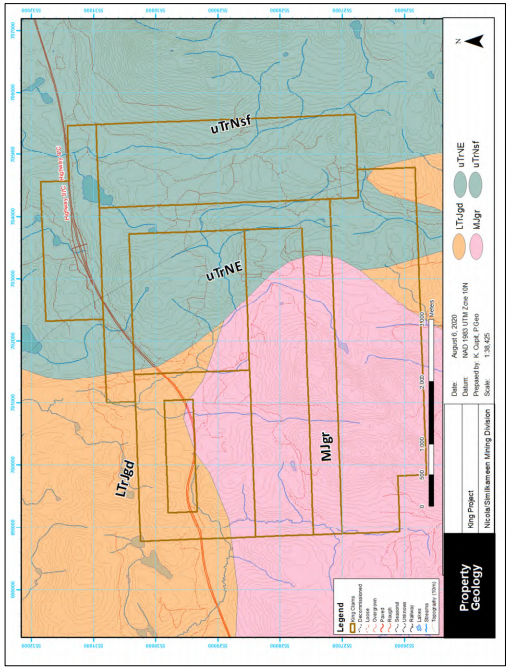
Figure 6: Minfile Showings
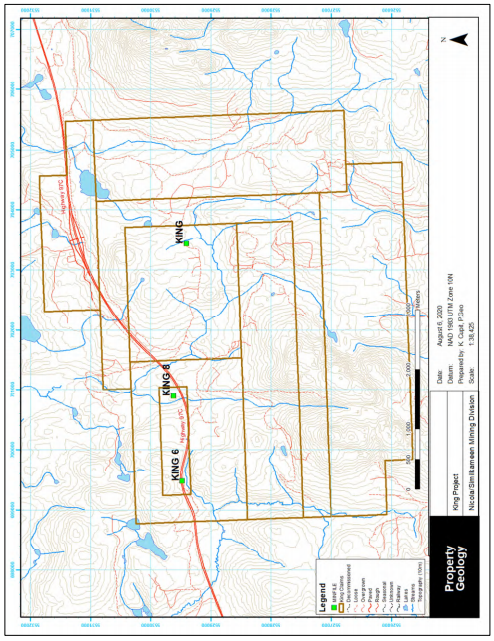
DEPOSIT TYPES
Based on the location and of the King Property and known area geology there is the potential for three
different deposit types: Polymetallic veins containing Cu-Mo +/- Au porphyry mineralization; classic
porphyries; and IOCG/Iron Oxide Breccia and Veins:
MINFILE Showings Located on the Property
Veins occur as steeply dipping, narrow, tabular or splayed polymetallic (Fe ± Cu ± U ± Au ± REE).” The
deposits exhibit strong structural controls, being emplaced along faults and contacts synchronous with
intense hydrothermal alteration and brecciation. The mineralogy consists of hematite (variety of forms),
specularite, magnetite, bornite, chalcopyrite, chalcocite, pyrite; digenite, covellite, native copper, carrolite,
cobaltite, Cu-Ni-Co arsenates, pitchblende, coffinite, brannerite, bastnaesite, monazite, xenotime,
florencite, native silver and gold, and silver tellurides.
Figure 7: Deposit Model
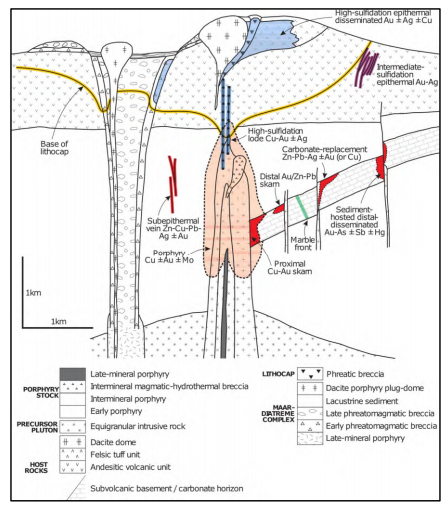
EXPLORATION
Stream Sediment Survey
In 2020 the Company collected 54 property wide stream sediments samples which resulted in the
samples taken in the eastern portion of the property returning an anomalous sample of 243 ppb gold
and 38.3 ppm copper. Copper values on Claim # 1074978 all gave elevated copper values ranging
from 31.2 to 51.2 ppm (see Figure 8 and Figure 9).
Soil Geochemistry
Rock Samples
Petrographic Samples
Figure 8: 2020 Gold in Streams
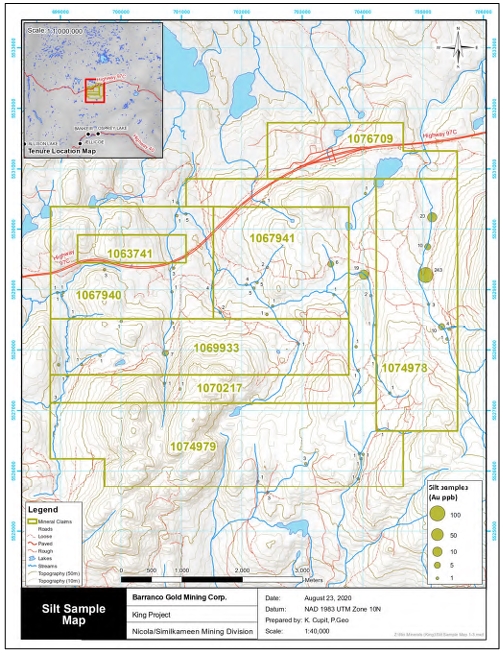
Figure 9: 2020 Copper in Streams
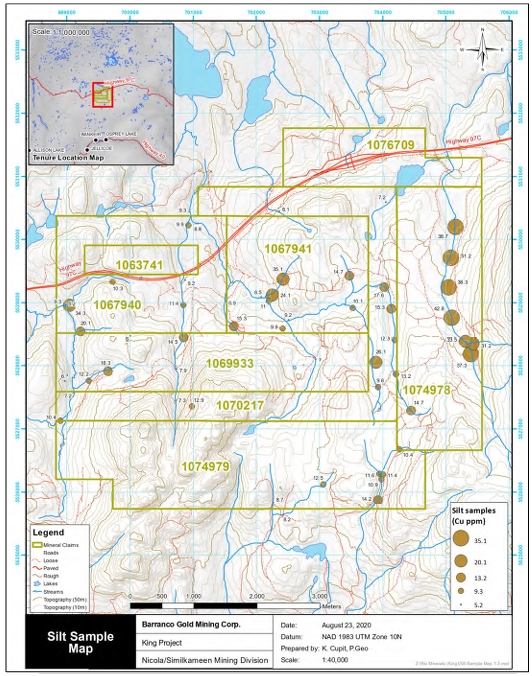
Figure 10: Copper in Soils
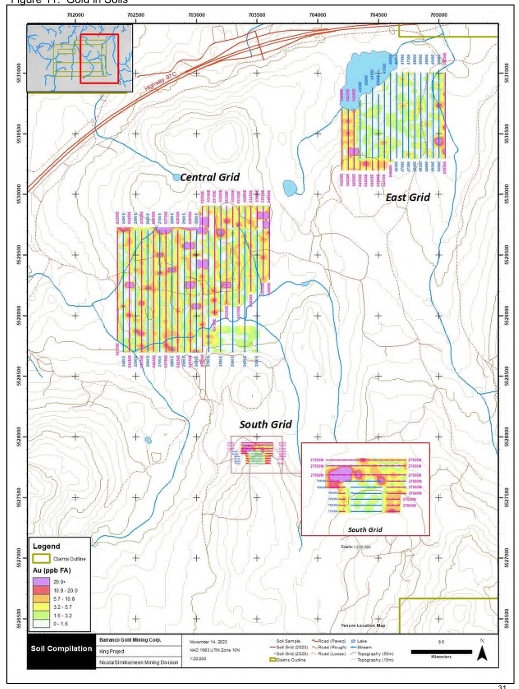
Figure 12: Zinc in Soils
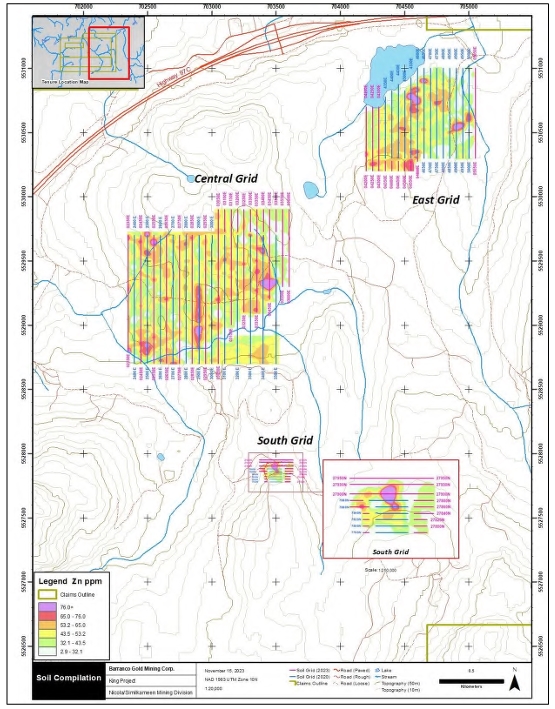
Figure 13: Lead in Soils
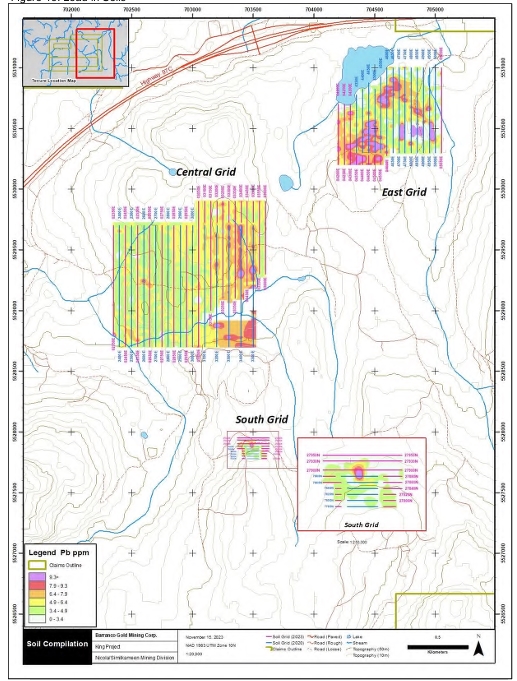
Figure 14: 2020 Rock Samples
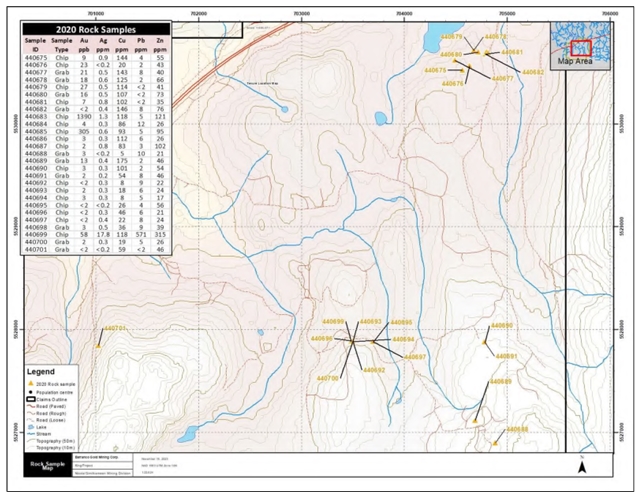
Figure 15: 2023 Rock Samples
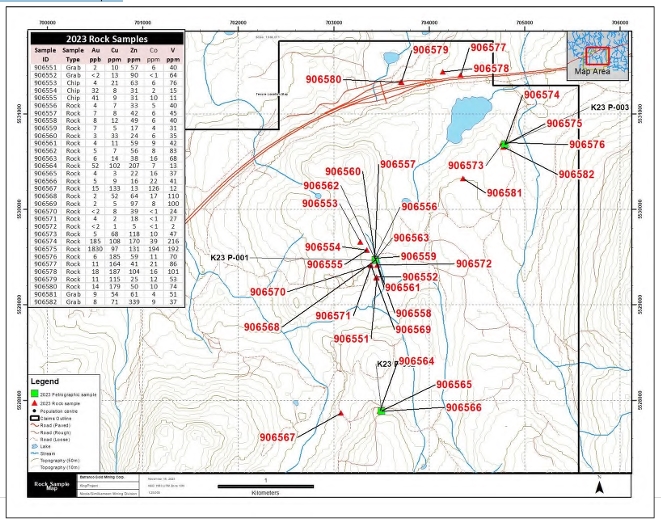
Anatomy of a telescoped porphyry Cu system showing spatial interrelationships of a centrally located porphyry
Cu ±Au ±Mo deposit in a multiphase porphyry stock and its immediate host rocks; peripheral proximal and distal
skarn, carbonate-replacement (chimney-manto), and sediment-hosted (distal-disseminated) deposits in a
carbonate unit and sub-epithermal veins in noncarbonate rocks; and overlying high- and intermediate-sulphidation
epithermal deposits in and alongside the lithocap environment. The legend explains the temporal sequence of
rock types, with the porphyry stock predating maar diatreme emplacement, which in turn overlaps lithocap
development and phreatic brecciation. (Sillitoe, 2010).
DRILLING
SAMPLING PREPARATION, ANALYSIS, AND SECURITY
Soil Samples
Rock Samples
Stream Sediment Samples
DATA VERIFICATION
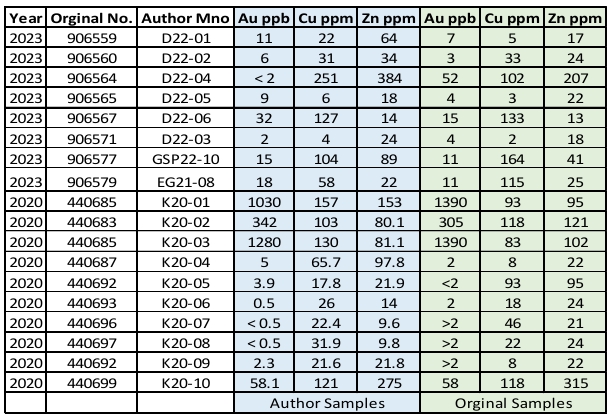
MINERAL PROCESSING AND METALLURGICAL TESTING
MINERAL RESOURCE ESTIMATE
THROUGH 22 ARE NOT APPLICABLE TO THIS REPORT
ADJACENT PROPERTIES
Elk Property Gold Mountain Mine
Gold mineralization occurs within quartz‐sulphide veins and stringers, most often within phyllic‐ and
silica‐altered Osprey Lake rocks and adjacent phyllic‐ and silica‐altered Nicola volcanic rocks. Pyrite
is the most common sulphide (Conroy, 1994), ranging from 5% to 80%, with higher percentages often
associated with chalcopyrite and tetrahedrite. Gold occurs as fine‐grained free gold (typically less than
50 µm) in quartz, and within quartz‐pyrite boxwork, and in fractures within veins (King, 2001). Gangue
minerals include quartz and altered wall‐rock clasts (xenoliths), with minor amounts of ankerite, calcite,
barite, and fluorite. Most of the previous mine production occurred within the quartz‐ monzonite and
granodiorite border phase of the batholith (Lewis, 2000).
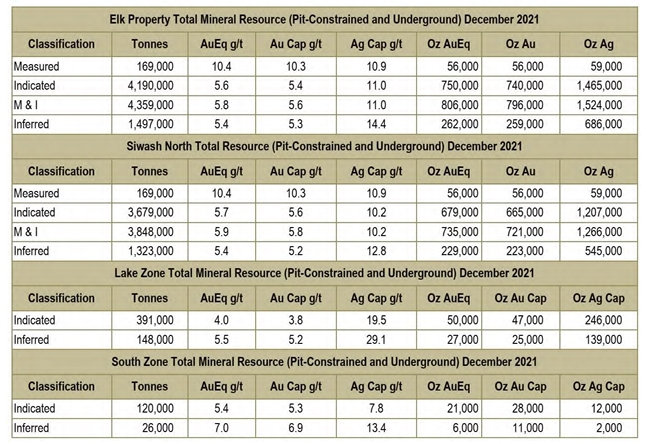
- CIM Definition Standards for Mineral Resources & Mineral Reserves were followed for the classification of Mineral Resources.
- Mineral Resources that are not Mineral Reserves do not have demonstrated economic viability.
- Results are presented in situ and undiluted.
- Mineral resources are reported at a cut-off grade of 0.3 g/t Au for pit-constrained resources and 3.0 g/t for underground resources.
- The number of tonnes and metal ounces are rounded to the nearest thousand.
- The Mineral Resource estimate includes both gold and silver assays. The formula used to combine the metals is: AuEq = ((Au_Cap*53.20*0.96) + (Ag_Cap 0.67*0.86))/(53.20*0.96)
- The Mineral Resource estimate is effective as of 21 October 2021.
- Ounces and tonnes have been rounded to the nearest thousand. The underground resource largely comprises several large, coherent groups of blocks so this
portion of the resource has not been constrained further
Brenda Mine
Table 5: Brenda Mine Historical Production from 1970-1990:
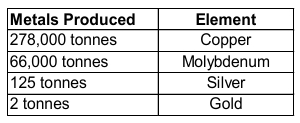
Figure 16: Adjacent Properties Locations
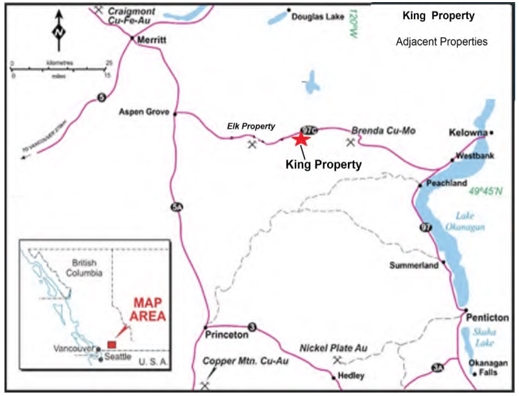
OTHER RELEVANT DATA AND INFORMATION
INTERPRETATION AND CONCLUSIONS
As a result of exploration programmes, the following areas of geological interest have been identified:
- Mineral claim 1074978 is of particular interest. Stream samples returned the best gold (243 ppb Au) and elevated copper throughout.
- The East Grid shows three separate samples with gold values over 20 ppm. The Central Grid has 21 samples with over 20 ppb gold. In the northern areas of lines 02950E to 03050E a grouping of elevated gold values has been identified with one sample returning 860 ppb gold. The 2023 samples on the South Grid resulted in a cluster of five samples with gold values over 20 ppm on the west side of the grid.
- The East Grid clearly shows an anomalous copper value on the west side of the grid east side with values up to 90 ppm. The Central Grid appears to have a general northwest – southeast trend of elevated copper.
- There is one line (02900E) where copper values are elevated with an assay of 52 ppm Cu. The South Grid has two elevated copper samples: 166 ppm and 51.6 ppm.
- In 2020, rock sample 440683 returned 1,390 ppb gold and 118 ppm copper. This site requires further investigation.
- In 2023 rock sample 906575 returned 1,830 ppb gold and 97 ppm copper. This site requires further investigation.
Additional work in these areas appears warranted.
RECOMMENDATIONS
The soil surveys are restricted to a small part of the claim group and should be expanded. The east
grid should be extended to the east and west. The central grid should be extended to the north. The
south grid should be extended to the north as well. A geochemist should be engaged to determine
the cause of the discrepancy between the 2020 and 2023 geochemical results.
The suggested work program includes a compilation of all historical geological, geophysical, and
geochemical data available for the King Property and the rendering of this data into a digital database
in GIS formats for further interpretation.
Proposed Budget:
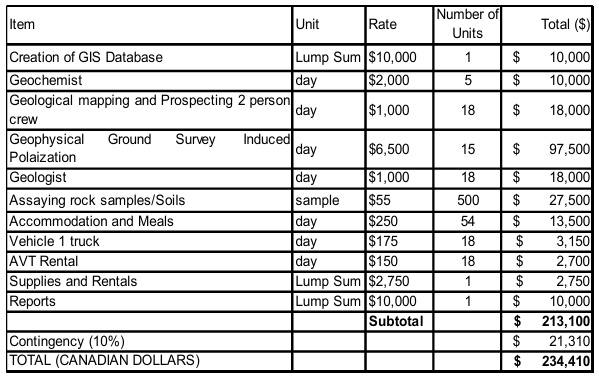
REFERENCES
Schiarizza, P., 2019. Geology of the Nicola Group in the Bridge Lake-Quesnel River area, south-central British
Columbia. In: Geological Fieldwork 2018, British Columbia Ministry of Energy, Mines and Petroleum Resources,
British Columbia Geological Survey Paper 2019-01, pp. 15-30.
Leitch, Craig 2023, Petrographic Report on 3 samples. By Vancouver Petrographic Ltd. Internal Company
document
CERTIFICATE OF AUTHOR
I, Derrick Strickland, do hereby certify as follows:
As of the effective date of this technical report, I am not aware of any information or omission of such information
that would make this Technical Report misleading. This Technical Report contains all the scientific and technical
information that is required to be disclosed to make the technical report not misleading.
Barranco Gold Mining Corp. is a Vancouver based company formed for evaluating, acquiring and exploring gold properties in Canada, advancing the King Gold Project in Canada’s newest gold district, the Spences Bridge Gold Belt.
Barranco is committed to the highest standards of environmental and social responsibility with a focus on generating positive outcomes and returns for all stakeholders.
© 2025 Barrancogold All rights Reserved
© 2024 Barrancogold
All rights Reserved
SIGN UP FOR NEWS
- Signup for our newsletter to get notified about our news updates.